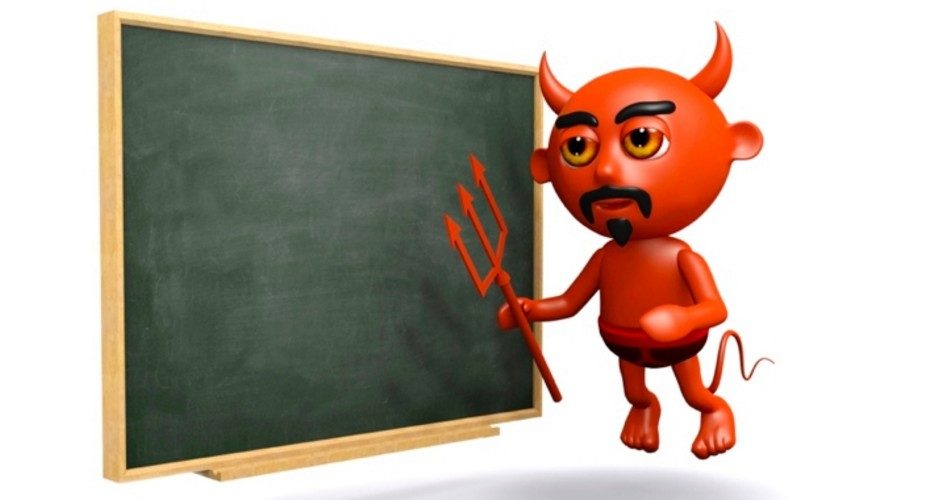
“The Devil went down to Georgia,” sang Charlie Daniels — now he has gone up to Colorado. But the matter isn’t a fiddling contest but fiddling while education burns, as some Centennial State schools plan to offer their students satanic and atheistic literature.
The materials are set to appear in the Delta County School District in Colorado April 1, but this is no joke. It’s the result of a policy, reports KJCT8 ABC, stating the district “cannot discriminate against any groups or organizations when it comes to non-curricular materials…. Kurt Clay, with the Delta School District[,] says if they are going to make literature for things such as Boy Scouts, 4H or other organizations available, they have to allow all types of information to be available to students.” So now, according to many, the Devil deserves equal access.
The group distributing the literature is the “Western Colorado Atheists and Freethinkers” (WCAF); its representatives say they were inspired to take action after Gideon Bibles were placed in the schools in December. All the materials in question are, once again, non-curricular; they won’t be assigned to students, but rather will occupy a library table and be available to read for those interested. It’s all very open-minded, although sometimes a mind can be so open that the brain falls out, as the quip goes.
The WCAF doesn’t appear to subscribe to Satanism but is instead pushing an agenda; they have said, for example, that they want to see a change in policy serving to completely “separate religion and schools.” So they’re just trying to make a point. And they have. Now let’s make the correct points.
The Delta schools’ position is contradictory. While they’re preaching an anti-discrimination principle, they will discriminate and ban material that “promotes hostility or violence, [serves] commercial purposes by advertising a product, interferes with the schools, promotes candidacy in an election or is obscene or pornographic,” KJCT8 ABC tells us. (Note: We could wonder if the WCAF’s literature promotes “hostility” toward those of faith.) Why these exceptions are made may seem self-evident. Yet since the proposition “Youth shouldn’t be exposed to Satanism” also appears a no-brainer, a bit of philosophical inquiry is in order.
Would it be “wrong” to allow in schools what the Delta district prohibits? If not, how is the prohibition justified? “It’s not wrong at all, but we just feel like banning something”? So, clearly, moral judgments are in play here; it’s wholly legitimate to discriminate based on materials’ “rightness” or “wrongness.”
Having said this, “religion” is the main focus in Delta; in fact, county schools are considering omitting religious materials altogether to end the controversy sparked by the WCAF (which is precisely what the organization wants). Yet the notion that God can’t be present in schools unless He shares the table with every occultist, pagan myth, and the Devil himself is itself a constitutional myth.
First, there is no “separation of church and state” (SCS) in the Constitution. The First Amendment merely stipulates that “Congress shall make no law respecting an establishment of religion, or prohibiting the free exercise thereof.” The SCS is constitutionally absent because it was a minority view at our nation’s founding. Thomas Jefferson did mention it in an 1802 letter to the Danbury Baptist Association, but merely to emphasize that, as president, he wouldn’t impose his unorthodox religious beliefs on others. Jefferson’s “wall” was a one-way filtration system: It kept government out of religion — not religion out of government.
In fact, Congress opened with prayers from the time of its very birth. In contrast, the radical SCS ruling — an example of Supreme Court activism — wasn’t foisted on America until 1947. Are we to believe that 20th-century lawyers knew more about the Constitution’s meaning than the men who wrote it?
Second, the First Amendment specifies, and limits, Congress, the federal government’s legislative body. It does this for a reason: The prohibition doesn’t apply to other levels of government. In fact, states had established churches at our nation’s inception.
Of course, the “Theory of Incorporation” (a judge-born rationalization) applied the Bill of Rights to the states. Even if one were to accept the theory’s legitimacy, however, it seems fanciful to apply it to a constitutional provision implicitly excluding the states by explicitly restricting only “Congress.”
And there’s yet another point. Whatever the First Amendment is (mis)applied to, the fact remains that it merely prohibits the “establishment” of religion. And making Bibles available in schools no more establishes religion than serving tacos at lunch establishes Mexican cuisine.
As for Colorado’s constitution, its final line does read that no “preference [shall] be given by law to any religious denomination or mode of worship.” But does anyone suppose the document’s 1876 Framers intended for this to dictate that the Devil must enjoy equal time in schools? Were that so (it’s not), it would be another example of a constitution that had become a “suicide pact,” to use Jefferson’s terminology, and amendment would be in order.
Having said this, law will tend to be corrupted by and come to reflect the age’s spirit. As long as people accept that “religion” alone should endure the discrimination of complete compartmentalization — as long as the Separation of Church and Everything Else reigns in people’s minds — an irrational separation of church and state will reign in our courts. So let’s examine the matter.
Consider: If the “religious” ideas in question really have been handed down by God, the Creator of the Universe and Inerrant Author of All, don’t we actually have a duty to infuse our public sphere with them? Is it not then an imperative that we immerse schoolchildren in this divine light? Of course, an atheist will respond, “Not everyone worships sky fairies! These are just man-made beliefs.”
And that’s where their argument collapses. After all, what then justifies putting the beliefs on the back of the bus? Why do you say the man-made beliefs we happen to call “secular” may be in the public square, but the man-made beliefs we happen to call “religious” may not be? If they’re all man-made, wherein lies the difference?
This reveals reality. It’s silly to say that “religious” ideas mustn’t be in the public square. There are only two possibilities: Either they’re man-made, in which case they can share the table with other man-made ideas and may be in schools.
Or they’re from God and must be in schools.
Of course, there is still one way to dispute the second proposition: to align with the Devil, who believes in God but rejects Him.
In truth, the injustice here would not be to discriminate between the saintly and the satanic, but between the “religious” and the “secular,” which, in the most important sense, is a false distinction. For how does this religious/secular discrimination model serve to separate the wheat from the chaff, the good influences from the bad? Is Nazism cleansed by being labeled “secular”? Does “Thou shalt do no murder” become bad counsel by being deemed “religious”? In reality, there is only one distinction that really matters: the true and the untrue.
Subordinating this distinction to the religious/secular one is a great con of our age. And with “educators” blind to the true/untrue divide, it’s no surprise we’re being divided with Lucifer and lies.



